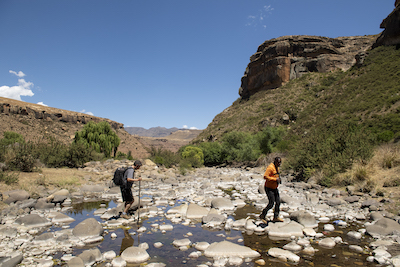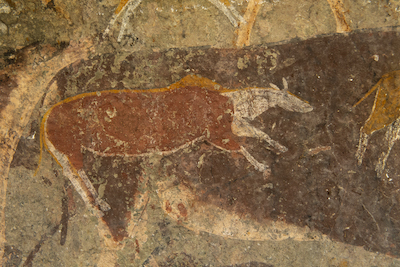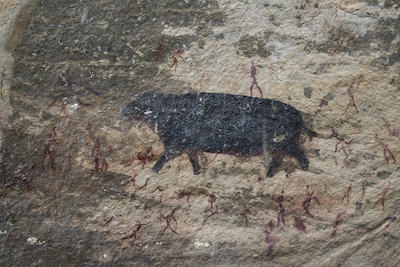
You are here: Explore > Places to Visit > Tsatsane Bushman Paintings
Tucked away in the remote southeast of Lesotho, the scenic valleys carved by the Tsatsane and Sebapala rivers host some of the finest prehistoric rock art anywhere in Southern Africa. Other attractions include trout fishing and cliffside nesting colonies of Cape and beaded vulture.
 The first rock art site you reach coming from Mount Moorosi is Ha Liphapang, where you are required to check in at the Tsatsane Valley community project office. The site here is easily reached on foot, though the crossing of the Sebapala River is potentially tricky when the water is high. Considered to be relatively modern (late 19th century), the fresco here incorporates a number of mysterious half-human, half-animal figures known as therianthropes, notably one large white figure with a rhebok-like head and small black horns.
The first rock art site you reach coming from Mount Moorosi is Ha Liphapang, where you are required to check in at the Tsatsane Valley community project office. The site here is easily reached on foot, though the crossing of the Sebapala River is potentially tricky when the water is high. Considered to be relatively modern (late 19th century), the fresco here incorporates a number of mysterious half-human, half-animal figures known as therianthropes, notably one large white figure with a rhebok-like head and small black horns.
The next site Motse Mocha is also easily accessed on foot, though again the river crossing could be problematic when it floods. This site is notable for incorporating several equine figures whose narrow striping and white belly clearly depict a Cape mountain zebra, suggesting either that the range of this localised species once extended far deeper into the eastern interior of Southern Africa than historical records indicate, or else that the artist hailed from further southwest.
About an hour’s walk or pony ride past Motse Mocha, passing the confluence of the Sebapala and tributary Tsatsane River, the remote village of Sekonyela stands opposite an outcrop containing two utterly superb rock art sites.
 Sekonyela 2 is possibly the most mind-boggling site of its type anywhere in Lesotho, containing hundreds of individual figures, most in a fair to good state of preservation. The centrepiece, a portrait of an eland measuring more than two metres long and one metre high, is the largest known depiction of this antelope, which was held sacred by the Bushman artists. Other striking images depict a traditional healer laying hands on a patient, a party of travellers carrying luggage on their heads, and a menagerie that includes what appear to be an aardvark, a hyena, and a young cheetah.
Sekonyela 2 is possibly the most mind-boggling site of its type anywhere in Lesotho, containing hundreds of individual figures, most in a fair to good state of preservation. The centrepiece, a portrait of an eland measuring more than two metres long and one metre high, is the largest known depiction of this antelope, which was held sacred by the Bushman artists. Other striking images depict a traditional healer laying hands on a patient, a party of travellers carrying luggage on their heads, and a menagerie that includes what appear to be an aardvark, a hyena, and a young cheetah.
 Action-packed Sekonyela 1 comprises a single fresco of around 50 humans and therianthropes hunting, fighting and dancing around what could be a buffalo bull, or a hippo, or a mythic creature containing elements of both. It is the most detailed and well-preserved surviving depiction of a type of rainmaking ceremony described to anthropologists in the late 19th century by one of the region’s last living Bushmen.
Action-packed Sekonyela 1 comprises a single fresco of around 50 humans and therianthropes hunting, fighting and dancing around what could be a buffalo bull, or a hippo, or a mythic creature containing elements of both. It is the most detailed and well-preserved surviving depiction of a type of rainmaking ceremony described to anthropologists in the late 19th century by one of the region’s last living Bushmen.
Two important vulture colonies can be found in the vicinity of the Tsatsane Valley. Selomong, a massive sandstone outcrop overlooking the road from Mount Moorosi, hosts at least 20 breeding pairs of the endangered Cape vulture. A more remote breeding colony, some six hours walk upriver from Motse Mocha, also hosts several pairs of the very rare bearded vulture.
Sleeping: Simple homestays are available at the community-based ecotourism project in Ha Liphapang. More distant options that could be used as the springboard for a day trip include the self-catering Mount Moorosi Chalets at the base of Mount Moorosi and a fair selection of hotels and guesthouses in Quthing.
Eating: Self-caterers should bring all the food they need from Quthing or Maseru. A handful of local-style eateries can be found in Mount Moorosi and Quthing.
Access: Tsatsane Valley is accessed along a 40km cul-de-sac that runs southeast from Mount Moorosi via Tsatsane Clinic and Ha Liphapang before terminating at Motse Mocha. The road takes about 90 minutes in either direction and is quite rough in parts; high clearance is essential and 4x4 is recommended. Public transport exists in the form of a few minibuses daily between Mount Moorosi and Tsatsane Clinic, and more occasional 4x4 minibuses that run on to Ha Liphapang and Motse Mocha. The rock art sites at Ha Liphapang and Motse Mocha are no more than 10 minutes’ walk from the road, but the 4km hike from Motse Mocha to Sekonyela 1 and 2 takes the best part of one hour in either direction. Allow seven hours for the full expedition from Mount Moorosi and another 90 minutes coming from Quthing.
Preparations: Mount Moorosi Chalets can arrange a guided self-drive or chauffeured visit to Tsatsane Valley, including the hike or horseback excursion to Sekonyela 1 and 2. It also offers day and overnight hiking trips to the bearded vulture breeding site to its south. Another possibility is to self-drive to Ha Liphapang and pick up a guide from the community project there.


